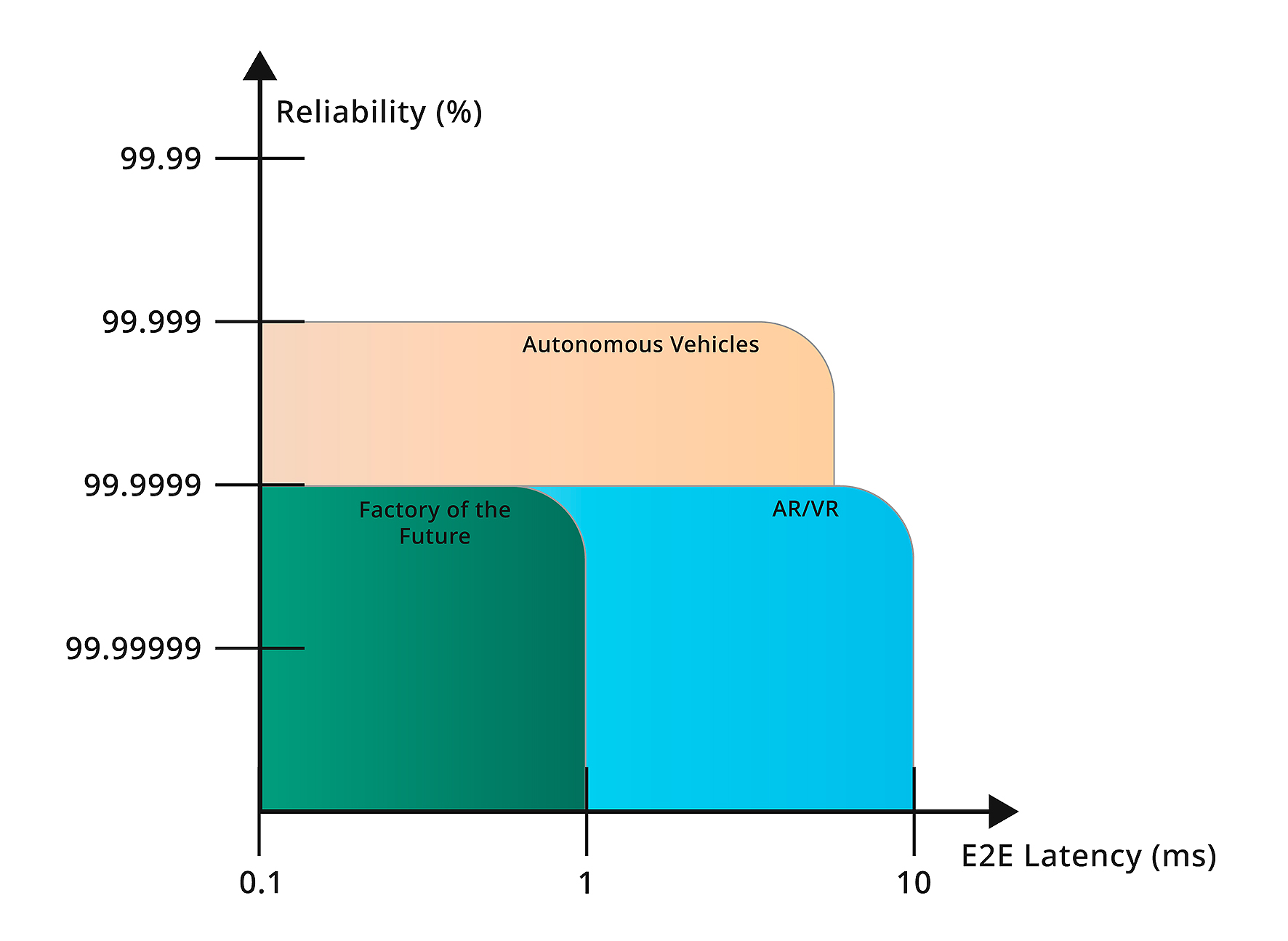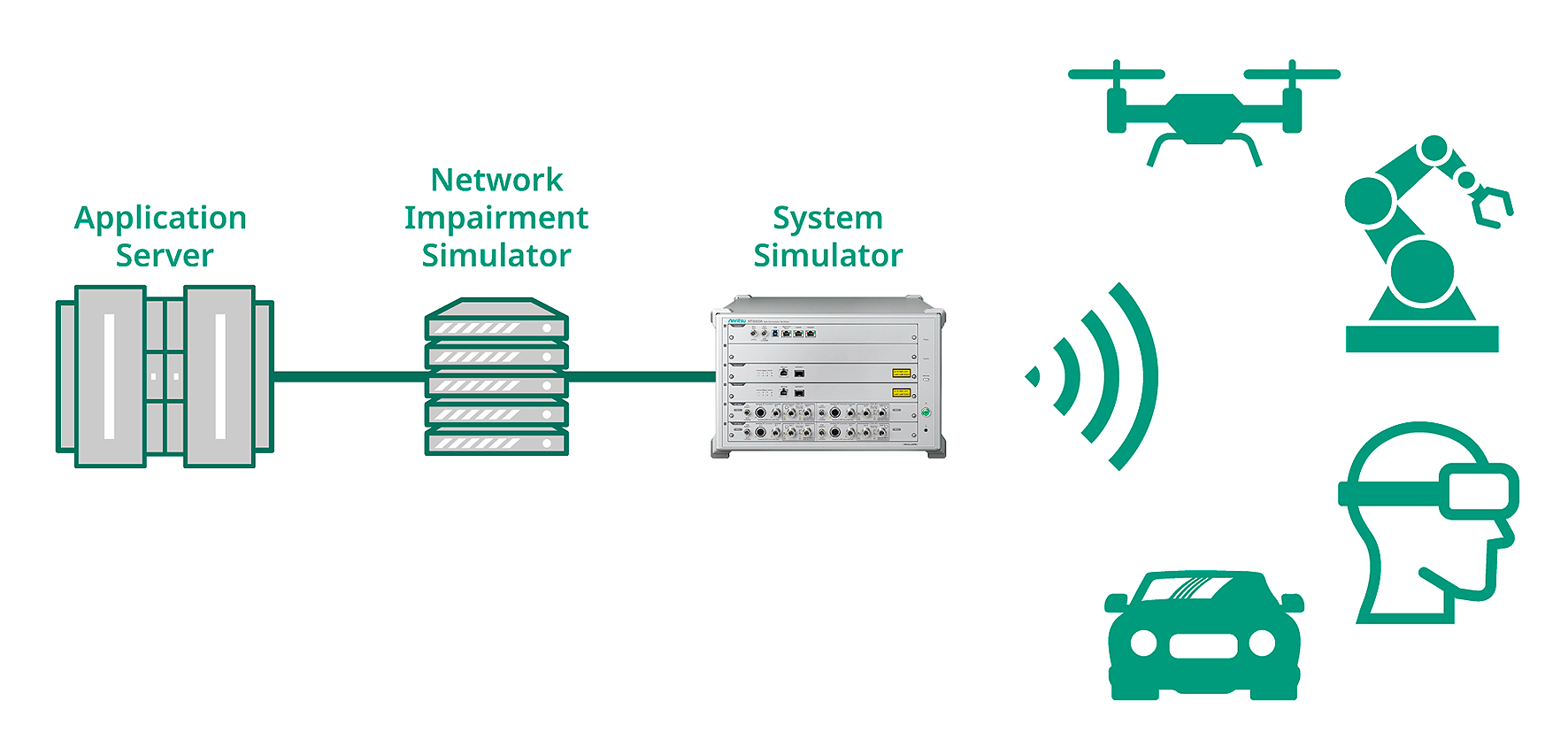URLLC application testing using system simulators
URLLC applications have stringent requirements for latency and reliability. This means we need to understand their performance envelopes to ensure their correct functioning and successful deployment in the field. To characterize the application’s performance, a wide range of conditions need to be tested, including testing extreme and rare events. Pavol Polacek, Wireless Specialist from Anritsu explains more.
With such knowledge, the application can be made more robust and fail-safe mechanisms put in place. A controlled environment with System Simulators (SS) can help to precisely characterise the requirements under which the application can function correctly and how a degradation in the quality of the communication link degrades the application’s performance.
Ultra Reliable Low Latency Communications
To cater to services with stringent requirements for latency and availability, 5G Ultra Reliable Low Latency Communications (URLLC) was defined. We can define URLLC by decomposing the acronym and looking at the requirements:
- Ultra Reliability requirementranging from between 99.99% for process monitoring to 99.999999% for industrial robots. This encompasses transmission loss, packet corruption or packet reordering, with all needing to be as low as possible.
- The End-to-end Low Latency Communication requirements range from under 0.5ms to 50ms on the application layer and under 1ms on the 5G radio interface, as specified for the user plane by the ITU-R [1] [2].
URLLC should thus provide a predictable communication environment to applications. We need to understand their performance envelopes to negotiate appropriate resources and QoS parameters, while using limited network resources efficiently.
URLLC Standardisation
The first 5G 3GPP release 15 defines the early steps towards URLLC by introducing the New Radio (NR) interface, with a latency of 1ms and a reliability of 99.999% [3]. To meet the URLLC requirements for end-to-end delay, a new end-to-end 5G architecture is defined - Stand Alone (SA). With its own 5G core, it can now operate without LTE and offers two important capabilities - network slicing and Multi-access Edge Computing (MEC).
With 3GPP release 16, further 5G core network feature enhancements supporting URLLC are the support of redundant transmission, QoS monitoring, dynamic division of the Packet Delay Budget, and enhancements of the session continuity mechanism. The NR physical layer has also seen improvements, like the capability to monitor the physical downlink channel, new formats of uplink control information, latency reduction mechanisms for hybrid automatic repeat request and others.
URLLC Applications
URLLC will enable new applications that are expected to be disruptive [4] [3] [5] [6], for example:
Augmented Reality and Tactile interaction provide additional information using a real world overlay. As well as its uses in entertainment, the technology is being developed for industrial applications like warehouse management and on-site repairs and could also cover critical applications such as augmented reality assisted surgery or remote surgery.
The Transportation industry will be able to field truly autonomous vehicles thanks to URLLC. Efficiency and safety will improve as vehicles and infrastructure make use of sophisticated sensors, artificial intelligence and near instantaneous communication. The main benefits of low latency will be seen in sensor sharing and remote driving.
Motion control encompasses machine tools, printing and packaging machines. Control of moving and rotating parts of machinery in a synchronised manner can be done via URLLC capable networks, enabling high efficiency.

Figure 1: URLLC application performance envelopes. As the figure shows, the application requirements can vary, and one approach is not suitable for all types of applications. Reservation of enough resources is paramount in achieving the desired QoS, while it is also important to use limited network resources efficiently by avoiding reserving their use unnecessarily.
Technology Enablers of URLLC
End-to-end latency generally depends on the network performance and distance between the server and user equipment. Both were optimised to suit URLLC applications. The sections below look at technology enablers in 5G:
5G New Radio
The air interface has been optimized for low latency through flexible numerology defining variable subcarrier spacing ranging from 15kHz to 240kHz, optimising scheduling for low latency by reducing scheduling intervals or using uplink grant-free transmission. Micro diversity, robust control channels and HARQ enhancements are important in reduce the probability of link failure and thus boosting reliability [3].
Network Slicing
Network slicing is a crucial 5G functionality of the SA architecture of the 5G core network. It allows resources to be allocated on demand for users with different service requirements from the radio interface up to the core network. Resources are flexibly partitioned and isolated from effects due to other users, creating an end-to-end logical channel [1].
Multi-access Edge Computing
Multi-access Edge Computing (MEC) greatly reduces latency and increases reliability by hosting the user applications at the 'Edge-side' as part of the Cloud -Radio Access Network. Hosting at the edge removes the need to go through the core network, while lowering the number of nodes on the data path also increases reliability [1].
Testing URLLC Application Performance
Different setups can be used to test applications, each with distinct characteristics and suitability for different stages of the application lifecycle:
- Testing in the field - is the most realistic set up but lacks reliable control over the test conditions. As a result, it is hard to repeat desired situations and testing can consume a lot of time and resources.
- Test network - provides greater control over the test environment, thus making the conditions easier to control, while providing a realistic network environment. However, by design such networks are not suited for testing negative scenarios and the control interfaces might also not provide enough control of all the components.
- System simulators - even though simplified in some aspects, when compared to the two previous setups, it gives the greatest control over the test environment, making it easier to automate and offering great repeatability. It can be easily set up under laboratory conditions, greatly reducing the effort and cost involved in testing.
Setup with a System Simulator
The setup with a system simulator, like the Anritsu MT8000A, consists of three main components, which can simulate a real life 5G NR SA network.
Application Server
The Application Server (AS) presents the counterpart to the Device Under Test (DUT), running the application processing device data and sending back the replies, be it control commands or graphical overlay. To stress test the application, the AS can simulate different negative scenarios from connectivity loss to excessive processing delay.
Network Impairment Simulator
The Network Impairment Simulator (NIS) simulates any negative effects on the traffic between the DUT and the AS. It is an easy way to simulate the behaviour of a link or network between the AS and the Radio Access Network (RAN).
System Simulator
An SS simulates the 5G radio access network, with several cells, beams etc. It provides an interface enabling a very detailed control of the cell parameters, be it physical layer parameters or protocol message content. One of the important capabilities is that network slicing can be configured, providing the basic requirement for URLLC applications.
Testing Scenarios
Different testing scenarios can be simulated:
- Latency - the value can represent both network and server processing latency. When delayed, packets can simply become expired and no longer useful
- Packet loss/reordering/corruption - while carried through a communication link or nodes, packets can get completely lost, partially corrupted or arrive out of order. The application needs mechanisms to cope with this, when packet retransmission is not desirable
- Insufficient throughput - some categories of URLLC applications will require substantial amounts of data to be transmitted continuously, so a drop in the available throughput can affect their functioning
- Connection loss - can occur on all three parts of the setup, requiring potentially different recovery mechanisms for each of them
- Mobility scenarios - changing the serving cell for another brings a potential risk during the handover or when the new cell cannot provide enough resources
- Radio transmission parameters change - wireless transmissions are inherently dynamic due to the nature of the medium. This means that the base station needs to adjust the transmission parameters, such as the number of resource blocks, modulation characteristics or power to cope with these changes. Interference can also be simulated to make the transmission more realistic

Figure 2: URLLC application performance testing setup, consisting of the application server, network impairment simulator and system simulator. The setup is flexible and can test applications ranging from drones to augmented reality.
Test Solution: MT8000A
The Anritsu MT8000A is a 5G NR system simulator, providing high performance and a scalable test platform for 5G NR, supporting Radio frequency, Protocol and Functional testing. A single MT8000A platform supports frequencies from less than 6GHz to 43GHz (millimetre wave), with broadband signal processing and beamforming technology. Throughput, latency or retransmissions can be evaluated under different PHY/MAC/RLC layer configurations. Advanced module based and software defined architecture mean it can be expanded to accommodate future technologies
It supports network slicing, enabling the testing of URLLC applications. Thanks to a powerful remote-control capability, it can be automated easily, enabling a smooth integration with other system components.
Conclusion
Understanding the performance envelopes of new 5G URLLC enabled applications is critical for their successful deployment in the field. This can be done efficiently in the laboratory before having to do any field trials, using system simulators like the MT8000A, capable of simulating 5G NR networks. The MT8000A provides a flexible and high performance platform, suitable for integration with other system components.


